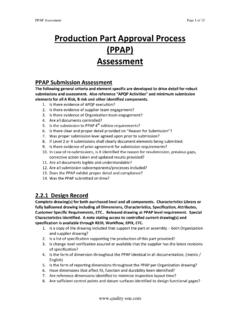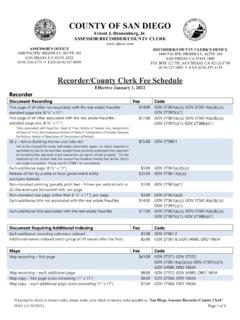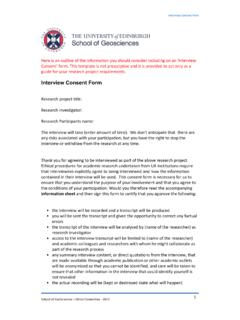Transcription of A Straightforward One-Seat Stereo Tuning Process and …
1 A Straightforward One-Seat Stereo Tuning Process and Some Notes About Why it Works The Process Note 1: This Process assumes the input to your DSP is confirmed as a flat, two-channel and in phase signal, like that of an aftermarket radio. Note 2: In an active system in which your tweeters are driven by an amplifier directly, install a capacitor in series with each tweeter to protect it from erroneous crossover settings, turn on and turn off pops and other failures that may destroy them. Choose a capacitor value that provides a -3dB point about an octave below the tweeter s Fs. Note 3: This is not an iterative Process in which you listen and then make an adjustment or two and then listen again to confirm an improvement.
2 Once you ve confirmed that all the speakers are connected and playing, there s no need to listen until after all of the settings have been made and you ve put away the RTA. Polarity, delay, crossovers, level and EQ, confirmation and additional level adjustments. That s the order. 1. Confirm that electrical polarity is correct. Use the markings on the speakers and the amps, a polarity checker or the UMI-1 and a scope. Do not set polarity by listening for a center image from speaker pairs! 2. Put the mic in the car. 3. Measure from the center of each speaker to the microphone. Estimate a straight line from the sub to the mic no matter which way the sub is facing.
3 If your system includes passive crossovers for the front speakers, measure to the midbass driver in a 3-way system or the midrange in a 2-way system. Input the distance or the delays depending on the DSP s requirements. Some processors will allow you to enter the delays as distance and some only in milliseconds. In those cases, you ll need to do the math. Be careful! Distance to the speakers and delays are not the same. See Setting Delays in a subsequent section. 4. Set the crossovers. Use 24dB/octave slopes and Linkwitz-Riley alignments. Set the subwoofer low pass filter an octave below the midbass high pass. For example, if your midbass high pass is 80 Hz, set the subwoofer at 60 Hz.
4 5. Equalize the left channel. Turn on the RTA, play the mono pink noise track from the Audiofrog Stereo Tuning CD (included with the UMI-1). Start with the left channel, including the subwoofer, and adjust the level controls on the amplifiers (or in the DSP) and the EQ to get as close to the target as you can. Save the measurement in the RTA. 6. Match the right channel to the left channel using the same Process . 7. Play mono pink noise through both channels at the same time. Look at the RTA display. This is the frequency response of your center image. If you see a BIG dip or a series of big dips (9dB or more), then your delay settings are incorrect or the signal into your processor includes delay or phase EQ.
5 Go back and check to see if the DSP needs the distances from the mic to the speaker or the delay settings. If your delay settings are correct, check the input signal. 8. Use the bandwidth limited pink noise tracks on the Audiofrog Stereo Tuning CD included with your UMI-1 (2-5) to check for center placement of the various bands. Don t be too concerned about exact placement. We re not concerned with the details here. The pink noise should not seem to come from either the left or the right speaker but from an area in between. The position of the high frequencies in track 5 will be less defined. This is because of high frequency reflections from the dash and the windshield.
6 That s OK. 9. Use tracks 6-20 to confirm image placement. The images should move smoothly and evenly across the dash. Left and Right tracks should come from the left and right speakers. Center tracks should be in the center of the dashboard. Left of Center and Right of Center tracks should appear halfway in between the Left and Center or right and center locations. If the center is too far to the left, turn the entire left channel down a little. If it s too far to the right, turn the right channel down a little bit. Do not adjust delays to move the image. 10. Check for noise using Track 38. If you hear a hissing sound from the tweeters and you don t like it, turn ALL the amplifier input sensitivity controls down by exactly the same amount until it goes away.
7 If the system isn t loud enough, you ll need to strike a balance between the presence of some noise and appropriate system level. That s it. Why This Process Works Additional Explanation It s all subjective and there s no right or wrong. I hear this all the time, and it simply isn t true. Stereo recordings are designed to do something specific and there are some aspects of music reproduction that aren t addressed in a simple Stereo recording . There are lots of misconceptions about what a Stereo recording actually is, so we ll cover some basics before we get started with Tuning automotive Stereo systems. Direct to Two-Channel In a direct to 2-channel recording , a pair of microphones, arranged to capture the live event are placed in the performance space as in the picture below (from Sweetwater): Each of the mics is connected directly to one of two channels in a recording device.
8 From here on out, we will refer to that device as a Digital Audio Workstation , or DAW , which is usually a computer program that receives its inputs from an audio interface. That audio interface converts the analog signals from microphones and instruments connected directly to it into digital signals that the computer program can use. In a direct to 2-channel recording , the microphones capture the sound that arrives at the mic directly from the instruments. They also capture the reflected sound that arrives at the mic after bouncing off the floor, the ceiling and the walls surrounding the recording space. The level and phase at which the direct sound arrives at the two microphones, and consequently in the two channels, determines their placement from left to right in the recording .
9 The reflected sound captured at the microphones helps to place the musicians in a room the recording space. If the recording is played back over two speakers arranged in the same space as the recording in roughly the position of the left and right most instruments, the reproduction will be believable. The sounds from the speakers will be reflected in much the same way as the sound of the original instruments and we ll have reproduced the performance pretty well. The dispersion characteristics of the speakers will affect the believability, but we ll ignore that for this part. If we play the recording over two speakers in a similar room, then the reproduction will be similar.
10 The degree to which the size and shape of the room in which we place the speakers is similar to the original recording space will determine how close we get to the actual performance. This is why some of the audiophile labels (see Mapleshade for an example) often bring musicians into a residential space like a living room and make a direct to 2-channel recording to be played back over a high quality pair of loudspeakers in a similar residential space. The interior of a car is not similar to the original performance space. If the system is properly designed and tuned, you ll be able to hear the placement of the musicians from left to right between the speakers.



